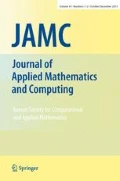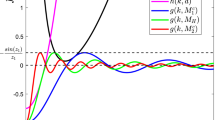Abstract
In this paper, we propose and analyse a mathematical model to study the mathematical aspect of reaction diffusion pattern formation mechanism in a predator-prey system. An attempt is made to provide an analytical explanation for understanding plankton patchiness in a minimal model of aquatic ecosystem consisting of phytoplankton, zooplankton, fish and nutrient. The reaction diffusion model system exhibits spatiotemporal chaos causing plankton patchiness in marine system. Our analytical findings, supported by the results of numerical experiments, suggest that an unstable diffusive system can be made stable by increasing diffusivity constant to a sufficiently large value. It is also observed that the solution of the system converges to its equilibrium faster in the case of two-dimensional diffusion in comparison to the one-dimensional diffusion. The ideas contained in the present paper may provide a better understanding of the pattern formation in marine ecosystem.
Similar content being viewed by others
References
Abraham, E.R.: The generation of plankton patchiness by turbulent stirring. Nature 391, 577–580 (1998)
Ahmed, S., Rao, M.R.M.: Theory of Ordinary Differential Equations with Applications in Biology and Engineering. East-West Press, New Delhi (1999)
Brentnall, S.J., Richards, K.J., Brindley, J., Murphy, E.: Plankton patchiness and its effect on large-scale productivity. J. Plankton Res. 25(2), 121–140 (2003)
Chen, B., Wang, M.: Qualitative analysis for a diffusive predator-prey model. Comput. Math. Appl. 55(3), 339–355 (2008)
Denman, K.L.: Covariability of chlorophyll and temperature in the sea. Deep-Sea Res. 23, 539–550 (1976)
Dubey, B., Das, B., Hussain, J.: A predator-prey interaction model with self and cross- diffusion. Ecol. Model. 171, 67–76 (2001)
Dubey, B., Hussain, J.: Modelling the interaction of two biological species in polluted environment. J. Math. Anal. Appl. 246, 58–79 (2000)
Dubois, D.M.: A model of patchiness for prey-predator plankton populations. Ecol. Model. 1, 67–80 (1975)
Du, Y., Shi, J.: A diffusive predator-prey model with a protection zone. J. Differ. Equ. 229, 63–91 (2006)
Fasham, M.J.R.: The statistical and mathematical analysis of plankton patchiness. Oceanogr. Mar. Biol. Annu. Rev. 16, 43–79 (1978)
Freedman, H.I., So, J.H.W.: Global stability and persistence of simple food chains. Math. Biosci. 76, 69–86 (1985)
Grieco, L., Tremblay, L.-B., Zambianchi, E.: A hybrid approach to transport processes in the Gulf of Naples: an application to phytoplankton and zooplankton population dynamics. Cont. Shelf Res. 25, 711–728 (2005)
Huo, H.-F., Li, W.-T., Nieto, J.J.: Periodic solutions of delayed predator-prey model with the Beddington-DeAngelis functional response. Chaos Solitons Fractals 33(2), 505–512 (2007)
Ko, W., Ryu, K.: Non-constant positive steady-states of a diffusive predator-prey system in homogeneous environment. J. Math. Anal. Appl. 327, 539–549 (2007)
Ko, W., Ryu, K.: A qualitative study on general Gauss-type predator-prey models with non-monotonic functional response. Nonlinear Anal.: Real World Appl. (2008). doi:10.1016/j.nonrwa.2008.05.012
Li, W.-T., Wu, S.-L.: Traveling waves in a diffusive predator-prey model with Holling type-III functional response. Chaos Solitons Fractals 37, 476–486 (2008)
Liu, Q., Li, B., Jin, Z.: Resonance and frequency-locking phenomena in spatially extended phytoplankton-zooplankton system with additive nose and periodic forces. J. Stat. Mech.: Theory Exp. (2008). Article no. po5011
Levin, S.A., Segel, L.A.: Hypothesis for origin of planktonic patchiness. Nature 259, 659 (1976)
Ludwig, D., Jones, D., Holling, C.: Qualitative analysis of an insect outbreak system: the spruce budworm and forest. J. Anim. Ecol. 47, 315–332 (1978)
Malchow, H.: Spatio-temporal pattern formation in nonlinear non-equilibrium plankton dynamics. Proc. R. Soc. Lond. B 251, 103–109 (1993)
Malchow, H.: Nonlinear plankton dynamics and pattern formation in an ecohydrodynamic model system. J. Mar. Syst. 7, 193–202 (1996)
Medvinsky, A.B., Tikhonova, I.A., Aliev, R.R., Li, B.L., Lin, Z.S., Malchow, H.: Patchy environment as a factor of complex plankton dynamics. Phys. Rev. E 64, 021915-7 (2001)
Medvinsky, A.B., Petrovskii, S.V., Tikhonova, I.A., Malchow, H., Li, B.L.: Spatiotemporal complexity of plankton and fish dynamics. SIAM Rev. 44(3), 311–370 (2002)
Murray, J.D.: Mathematical Biology. Springer, Berlin (1989)
Platt, T.: Local phytoplankton abundance and turbulence. Deep-Sea Res. 19, 183–187 (1972)
Scheffer, M.: Fish and nutrients interplay determines algal biomass: a minimal model. OIKOS 62, 271–282 (1991)
Segel, L.A., Jackson, J.L.: Dissipative structures: an explanation and an ecological example. J. Theor. Biol. 37, 545–559 (1972)
Stamov, G.T.: Almost periodic models in impulsive ecological systems with variable diffusion. J. Appl. Math. Comput. 27, 243–255 (2008)
Thomas, J.: Numerical Partial Differential Equations: Finite Difference Methods. Texts in Applied Mathematics. Springer, New York (1995)
Turing, A.M.: On the chemical basis of morphogenesis. Philos. Trans. R. Soc. Lond. Ser. B 237, 37–72 (1952)
Upadhyay, R.K., Kumari, N., Rai, V.: Wave of chaos in a diffusive system: generating realistic patterns of patchiness in plankton-fish dynamics. Chaos Solitons Fractals (2007). doi:10.1016/j.chaos.2007.07.078
Upadhyay, R.K., Kumari, N., Rai, V.: Wave of chaos and pattern formation in spatial predator-prey systems with Holling type IV predator response. Math. Model. Nat. Phenom. 3(4), 71–95 (2008)
Vilar, J.M.G., Sole, R.V., Rubi, J.M.: On the origin of plankton patchiness. Phys. A: Stat. Mech. Appl. 317, 239–246 (2003)
Wolpert, L.: Positional information and the spatial pattern of cellular differentiation. J. Theor. Biol. 25, 1–47 (1969)
Wolpert, L.: The development of pattern and form in animals. Carol. Biol. Read. 1(5), 1–16 (1977)
Xiao, J.-H., Li, H.-H., Yang, J.-Z., Hu, G.: Chaotic Turing pattern formation in spatiotemporal systems. Front. Phys. China 1, 204–208 (2006)
Author information
Authors and Affiliations
Corresponding author
Rights and permissions
About this article
Cite this article
Dubey, B., Kumari, N. & Upadhyay, R.K. Spatiotemporal pattern formation in a diffusive predator-prey system: an analytical approach. J. Appl. Math. Comput. 31, 413–432 (2009). https://doi.org/10.1007/s12190-008-0221-6
Received:
Revised:
Published:
Issue Date:
DOI: https://doi.org/10.1007/s12190-008-0221-6




